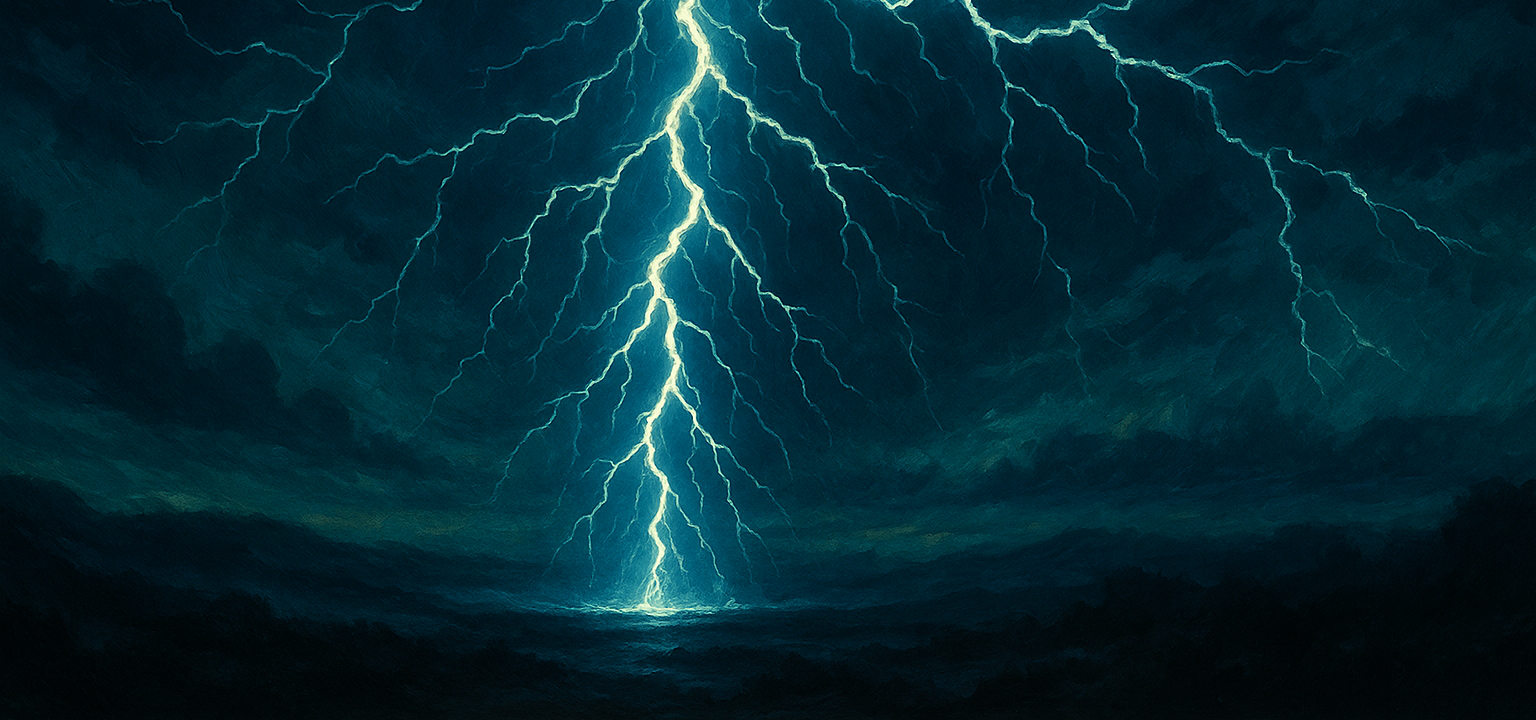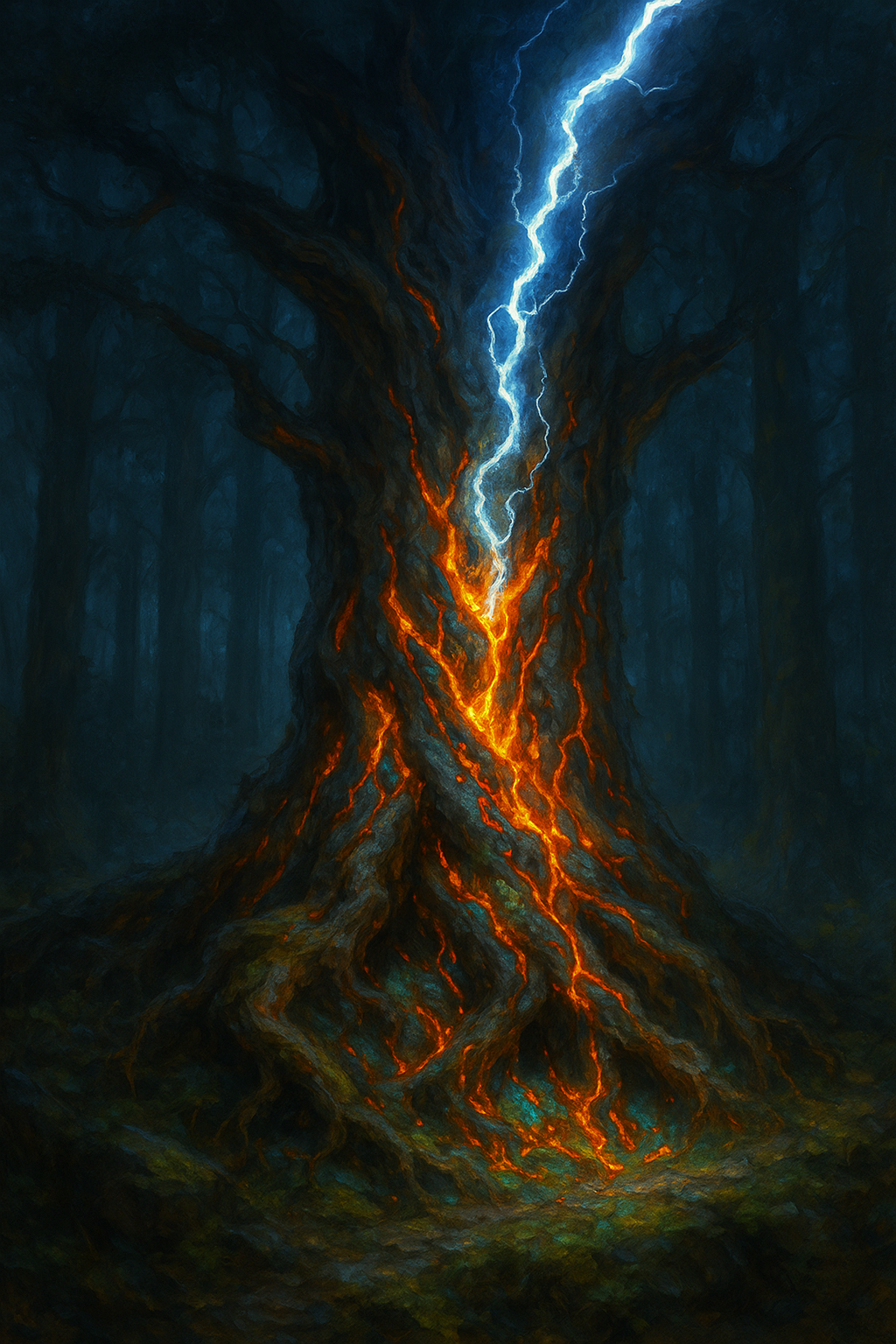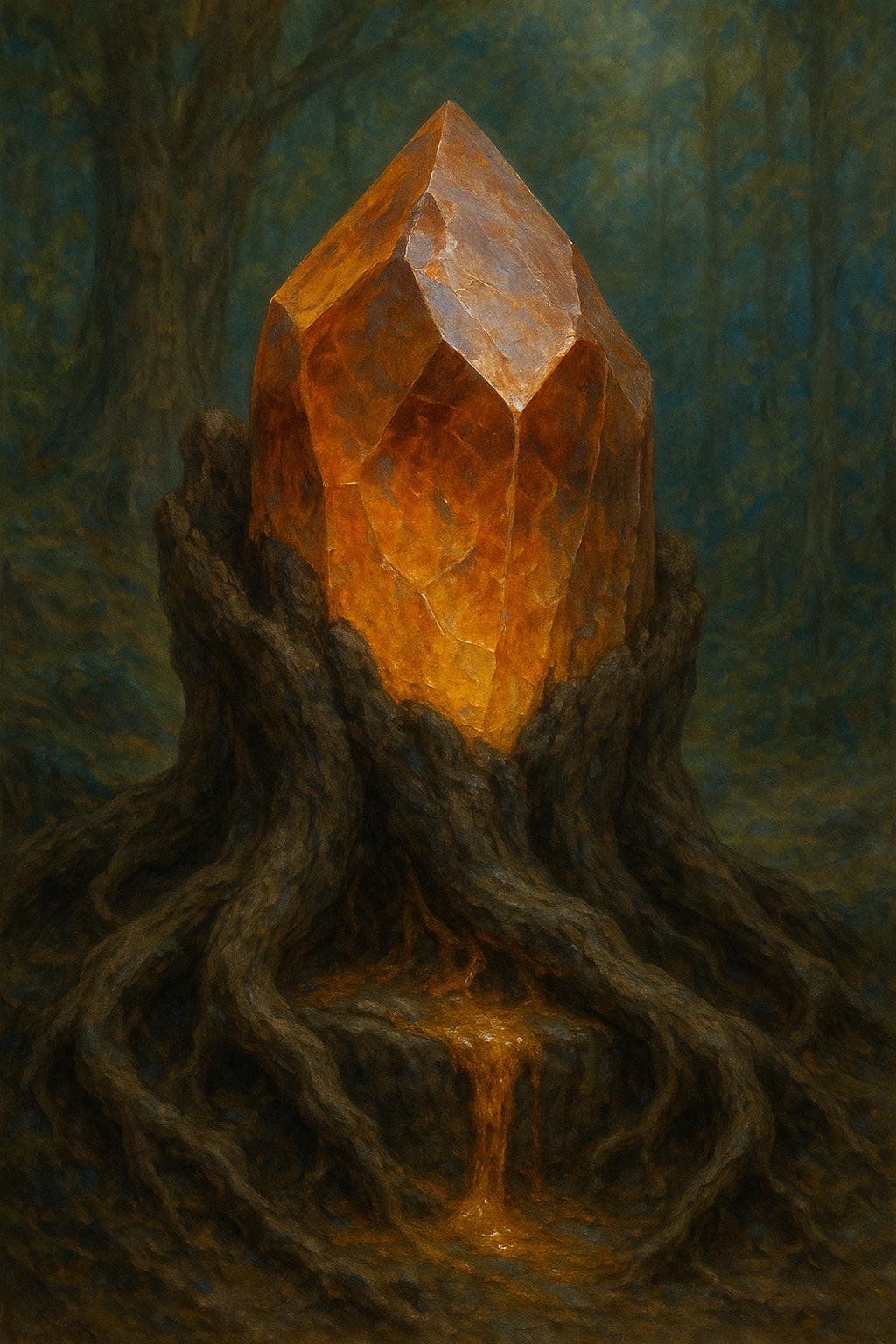Cinderglass Resin
Cinderglass Resin is a rare, volatile substance formed when trees are struck by arcane lightning or exposed to unstable leyline surges. What begins as a thick, amber-colored sap crystallizes over days or weeks into sharp, glass-like shards that glow faintly with inner fire. The resulting material is brittle to the touch, but burns hot and fast when ignited, emitting a distinctive smell of scorched sugar, ozone, and distant thunder.
Though it resembles a gemstone or shard of colored glass, Cinderglass is a botanical byproduct, born of trauma, not mineral pressure. It is often found embedded in scorched bark or buried at the roots of trees that have survived magical storms. Harvesting it is dangerous work, as residual energy can lash out or attract lightning elementals.
Mages who've handled it frequently can be identified by the faint scorch-sweet smell clinging to their robes and fingers.
Properties
Material Characteristics
Apperance:
Translucent and sharp-edged, Cinderglass forms as jagged shards, veins, or crystalline clusters embedded in the bark or roots of trees struck by arcane lightning. The surface is glassy but uneven, often fractured with web-like inclusions resembling frozen bolts of lightning.Color:
Typically ranges from deep amber to fiery orange-red, with common streaks of glowing gold or blue-white arcs. Rare leyline-touched variants exhibit violet, green, or even shifting hues under moonlight.Texture:
Smooth to the touch, but fragile—edges can slice skin easily. When raw or freshly formed, it has a sticky, sap-like underside before fully crystallizing. Some describe it as feeling “warm and alive” even when inert.Glow/Bioluminescence:
Emits a faint, pulsing glow in darkness—strongest during storms or in the presence of spellcasting. The glow increases in intensity when exposed to heat, emotion, or strong ambient magic.Weight/Density:
Slightly denser than glass (approx. 2.5 g/cm³). Feels heavier than it looks, especially in shard form.Sound Response:
When tapped, produces a soft chiming or thrumming tone, like a tuning fork. Under extreme cold, it hums faintly without provocation.Fracture Behavior:
Shatters explosively under physical duress or if magically destabilized. Shards remain dangerously sharp and can retain magical charge.Burn Behavior:
Burns hot and bright, leaving no ash. Produces a sweet-scorched scent and occasionally small arcane sparks during combustion.Compounds
Embersteel
An alloy of Cinderglass Resin, iron, and powdered fire opal. Used in the forging of magically conductive weapon cores and spell-tempered armor. Burns with an inner heat when exposed to rage, adrenaline, or combat magic. Rare and highly volatile during the smithing process.Auric Temper
A brittle enchantment coating made by dissolving Cinderglass fragments in charged quicksilver and binding agents. Applied to weapons or tools to enhance elemental affinity, usually lightning or fire. Popular among battle-mages and rune-smiths.Leythread Glass
Refined from Cinderglass and woven into thin, flexible filaments. Used in the creation of magical circuits, scrying mirrors, and arcane interfaces. Sensitive to leyline pulses and functions like organic circuitry in high-end magical tech.Life & Expiration
Cinderglass doesn't decay in a traditional sense, but it does lose magical potency over time. In inert conditions (cool, dry, magically neutral), the ambient arcane charge within Cinderglass dissipates by half over approximately 7–10 years. After about 30–40 years, most ambient charge is gone unless recharged manually or stored near a leyline or enchantment field.
While physically stable for centuries, its magical structure becomes brittle with age. As the inner energy fades, it loses responsiveness to heat, storms, or spells, and the glow dulls to a faint flicker. Very old samples may crumble into inert, colored dust if not preserved.
History & Usage
Refinement
How Cinderglass Resin Is Used and Manufactured Despite Its Volatility
Cinderglass isn’t harvested or refined like a normal material—it’s tamed. Specialized crafters known as arcane stabilizers, stormforged alchemists, or resonance smiths handle it using a combination of containment magic, emotional regulation, and environmental control. First, during harvest, no one touches raw Cinderglass with bare hands. It’s usually extracted while still partially embedded in bark or root, using insulated tools of obsidian, bone, or non-conductive crystal. Most harvesters wear magically dampened armor or grounding rings to prevent ambient charge buildup. Some even bring along charm casters or druids to calm the area—because emotional spikes can trigger a sympathetic reaction. Once harvested, shards are placed in null-magic containment boxes, usually lined with voidglass or lead-tempered silver. These boxes block leyline interference, magical auras, and even strong emotions from triggering the resin. In some cities, transporters use emotionless constructs or golems to carry the boxes across long distances. In the lab or forge, Cinderglass is refined in short pulses. The trick isn’t to melt or grind it all at once—but to “coax” it into reacting slowly, using carefully timed alchemical catalysts and temperature shifts. The moment it’s agitated too fast, the risk of detonation spikes. Refiners often work in rotating shifts, with one mage regulating ambient magic, another monitoring temperature, and a third applying anti-emotive wards to keep emotions low. It’s more like handling a cursed relic than a material.Cultural Notes:
In Drakoria, harvesting Cinderglass is a rite of passage for storm-bound cults and certain battle-mages. In Kamulos, it’s banned due to several alchemical accidents and a mage duel that lit a town on fire. Some believe sleeping near raw Cinderglass induces prophetic dreams—or catastrophic ones.Hazards
Cinderglass Resin is one of the most volatile naturally-occurring arcane materials in existence. Its most immediate danger is its fragility—under even moderate physical stress, it can shatter explosively. This isn’t a simple glass break; charged shards detonate with a concussive pop, sending razor-edged fragments in all directions. These splinters are not only capable of slicing through flesh and leather, but they also often retain residual magical charge, sparking erratically or even delivering jolts of elemental energy.
Its magical volatility makes it particularly hazardous in the presence of spellcasters. Cinderglass behaves like a magical capacitor—it absorbs ambient arcane energy and can violently release it when overcharged. Casting spells too close to a charged piece can result in dangerous feedback, misfires, or wild surges. Elemental spells, particularly fire, lightning, or any spell tied to emotion, risk triggering unpredictable reactions. Entire laboratories have been lost because a novice tried to identify a shard with detect magic.
When exposed to flame or intense heat, Cinderglass burns hot, fast, and dirty. The fire it produces is laced with arcane energy, capable of harming even creatures resistant to mundane flame. It leaves behind no ash, only scorched scent and sometimes temporary arcane aftershocks. During combustion, it emits a smell described as scorched sugar, ozone, and rain-charged air—pleasant, but extremely dangerous to inhale in quantity.
Even in an inert state, Cinderglass is hazardous. Its razor-sharp edges can slice through skin like obsidian, and when broken or ground into powder, inhalation becomes a serious risk. Fine Cinderglass dust can cause internal bleeding, arcane hallucinations, and a condition known as Arcane Contamination Syndrome (ACS)—a form of magical sickness marked by tremors, erratic spellcasting, and eventual mana burnout.
Certain samples of Cinderglass also exhibit emotional resonance. When brought near charged shards, individuals may experience heightened emotional states—anger, grief, longing, or elation. Some pieces respond to strong emotions, glowing brighter or humming faintly. Long-term exposure has been linked to recurring dreams of storms, whispers in thunder, or visions of lightning-struck landscapes. Some theorists believe the material stores echoes of the events that birthed it.
To handle Cinderglass safely, strict precautions are required. Shards must be stored in null-magic containers, typically lined with obsidian, lead, or voidglass. Arcane-insulated gloves and face coverings are standard when harvesting or transporting it. Storing it near spell scrolls, leyline maps, or enchanted objects is a recipe for catastrophe. Some fragments become nearly invisible when inert, so tagging them with glowstones or tracker glyphs is common among responsible alchemists.
Type
Wood
Value
Small shard (coin-sized) – 150–300 gp (more if it’s still charged)
Powdered Cinderglasss– 75 gp per ounce, used in minor enchantments or arcane inks
Powdered Cinderglasss– 75 gp per ounce, used in minor enchantments or arcane inks
Rarity
Very Rare due to both its volatile formation process and the dangers of harvesting it
Odor
The scent is unmistakable: sweet like burnt sugar, sharp like ozone. Some say it smells like a storm that hasn't hit yet—charged, electric, and wrong
Taste
Those foolish enough to lick or ingest raw Cinderglass report a taste that starts sweet and sticky, almost like burnt honey—then sharpens suddenly into a metallic tang that numbs the tongue.
Color
Cinderglass Resin ranges from deep amber to fiery red-orange, often shot through with iridescent veins of gold or crackling blue-white—like frozen lightning trapped in tree sap.
Boiling / Condensation Point
870°C (1600°F)
Melting / Freezing Point
510°C (950°F)/20°C (68°F)
Density
2.5 g/cm³
Common State
Solid (Crystalline Resin)






The safekeeping details sell the fragility and danger in handling it.